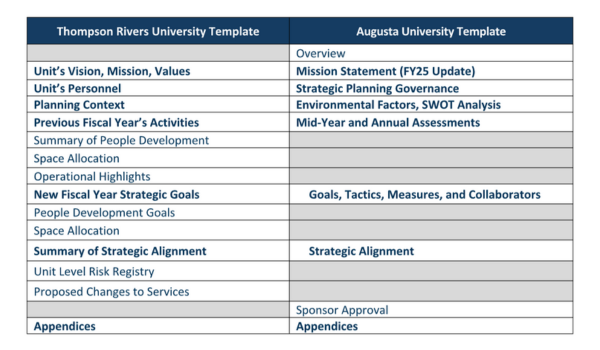- Integrated Planning
Integrated Planning
Integrated planning is a sustainable approach to planning that builds relationships, aligns the organization, and emphasizes preparedness for change.
- Topics
Topics
- Resources
Resources
Featured Formats
Popular Topics
- Events & Programs
Events & Programs
Upcoming Events
- Building Buy-in for Planning: Dealing With Resistance and Gaining Support
Online | March 11 – April 8 - Budgeting for Impact: A Working Group on Resource Planning in Higher Education
Online | Feb 5, Feb 19, March 5 - Cross-Functional Collaboration: Tools and Skills for Working Across Silos
Online | February 10, 17, 24
- Building Buy-in for Planning: Dealing With Resistance and Gaining Support
- Community
Community
The SCUP community opens a whole world of integrated planning resources, connections, and expertise.
- Integrated Planning
Integrated Planning
Integrated planning is a sustainable approach to planning that builds relationships, aligns the organization, and emphasizes preparedness for change.
- Topics
Topics
- Resources
Resources
Featured Formats
Popular Topics
- Events & Programs
Events & Programs
Upcoming Events
- Building Buy-in for Planning: Dealing With Resistance and Gaining Support
Online | March 11 – April 8 - Budgeting for Impact: A Working Group on Resource Planning in Higher Education
Online | Feb 5, Feb 19, March 5 - Cross-Functional Collaboration: Tools and Skills for Working Across Silos
Online | February 10, 17, 24
- Building Buy-in for Planning: Dealing With Resistance and Gaining Support
- Community
Community
The SCUP community opens a whole world of integrated planning resources, connections, and expertise.
 Blog Post
Blog PostSlight Differences and Lots of Similarities
Two Conference Presenters Both Advocate for Developing and Improving Planning CulturePublished August 9, 2024By Melodie Greer, MEd, Bryn Athyn CollegePlanning Types: Strategic PlanningChallenges: Engaging Stakeholders, Planning AlignmentTags: Alignment, Organizational Change, Organizational Culture, Planning Processes, SCUP 2024 Annual Conference, Unit Planning
Institutions referenced in this resource:
Thompson Rivers University, Augusta University, Bryn Athyn College of the New Church
Melodie Greer, MEd (Bryn Athyn College offers) her takeaways from two insightful presenters at the SCUP 2024 Annual Conference.
This was my first time attending a SCUP conference, and I attended ten sessions over the two days. One of those sessions was “Elevate Your Strategic Alignment Process Through Templates and Workshops.” The presenters came from different universities: Brittany Cipillone from Augusta University (AU) in Georgia and Dana Prymak from Thompson Rivers University (TRU) in British Columbia. I appreciated the collaboration and ease with which they shared the presentation.
Dana began with an overview of her university and noted how at TRU, Integrated Planning Services includes accountability and compliance reporting, information support and analysis, survey research, planning and foresight support, applied research, and enrollment management.
Next up, Brittany shared AU’s mission: “Become a comprehensive health sciences university with an R1 Carnegie Classification.” AU recently surpassed the five-digit student enrollment total, and its Institutional Effectiveness team covers accreditation, analytics, assessment, institutional reporting, integrated planning, new academic program planning, program review, project management, and survey research.
A takeaway from Brittany was something AU developed and what she termed “six tenets of integrated planning.” [Note: See SCUP’s description of Higher Education Integrated Planning.] They were:
- Include stakeholders in the planning process to build a durable culture to lead change.
- Create a responsive planning process that helps to respond to the changes in the environment and prepare for the unexpected.
- Build and foster durable cross-functional relationships.
- Coordinate action and implementation steps that propel the institution forward.
- Sustain the execution of a plan that links vision to operational tactics and resources.
- Apply continuous improvement and evaluation.
Dana and Brittany emphasized the need for vertical and horizontal alignment in planning. Vertical alignment runs from mission to vision, to strategic, to institutional, to unit levels, and should be bi-directional. Horizontal alignment is about crossing silos, looking at how various units can collaborate to accomplish institutional and strategic goals.
We at Bryn Athyn, a small (300-ish students), faith-based, liberal arts college, struggle to do this, so my hat’s off to larger colleges and universities that manage to accomplish it.
The presenters said the key to creating vertical and horizontal alignment is good communication, requiring a common language, which can be facilitated using an annual service plan. The plan translates strategy into action; is a roadmap of how units contribute to institutional goals in an open, transparent, and consistent way; and serves as a design for strategic plan implementation.
The following chart shows the main sections of each plan. Note the similarities and differences between the two universities. The presenters encouraged us to consider what would be useful for our institutions.

At AU, plan development takes place from September through March, starting with a strategic alignment planning retreat and then a workshop in January. Iterative updates and reviews with various administrators and institutional effectiveness staff occur between those events. Once the plans are complete, planning and resource alignment hearings are held, where each planning unit presents to a group of EVPs. This part of their process begins in July/August with an annual assessment and plan update. A mid-year update follows in January and alignment hearings in March. AU follows a continuous improvement cycle of plan, implement, analyze, and use results.
TRU follows a similar cycle. An important part of their process that I want to implement at my college is that from September–February, their Office of Interprofessional Education offers office hours, workshops, one-to-one support, and team consultations. I am discovering that not everyone has a planning mindset: proactively offering support for completing plans might help us reach our goal of 100 percent participation.
Another important piece of planning that Brittany and Dana discussed was developing/improving a planning culture—changing believers into advocates and challengers into collaborators. They mentioned the personas, with which you may already be familiar, we’ll encounter when working on a strategic plan:
Captain Solo: “I developed my own strategy and plan. Who needs teamwork?”
The Analysis Paralysis Pro: “We should analyze this from every possible angle. Let’s not rush into anything.”
But How About Me?: “I asked for X. Why doesn’t this plan reflect that?”
Plan Deniers: “This strategy is all wrong.”
Unrelenting Unicorns: “Our situation is unique; no one else has these problems. We’re special!”
Status Quo Champions: “Where we are is good enough. If it isn’t broke, don’t fix it!”
I learned from Brittany and Dana that when trying to change the culture, start small and gain momentum with every person you bring on board. By moving alignment to the forefront, everyone can see their role in making the college/university successful.
Author Biography
Melodie Greer, MEd, is the senior data administrator, one of three members of a newly formed Office of Integrated Institutional Effectiveness, at Bryn Athyn College in Bryn Athyn, Pennsylvania. Her team comprises several administrative functions, including data management and analysis, institutional research, assessment, effectiveness, and accreditation. Previously, she was the executive assistant to the College’s president, a curriculum coordinator, and teacher support for the General Church Schools system.
- Topics
- Topics


